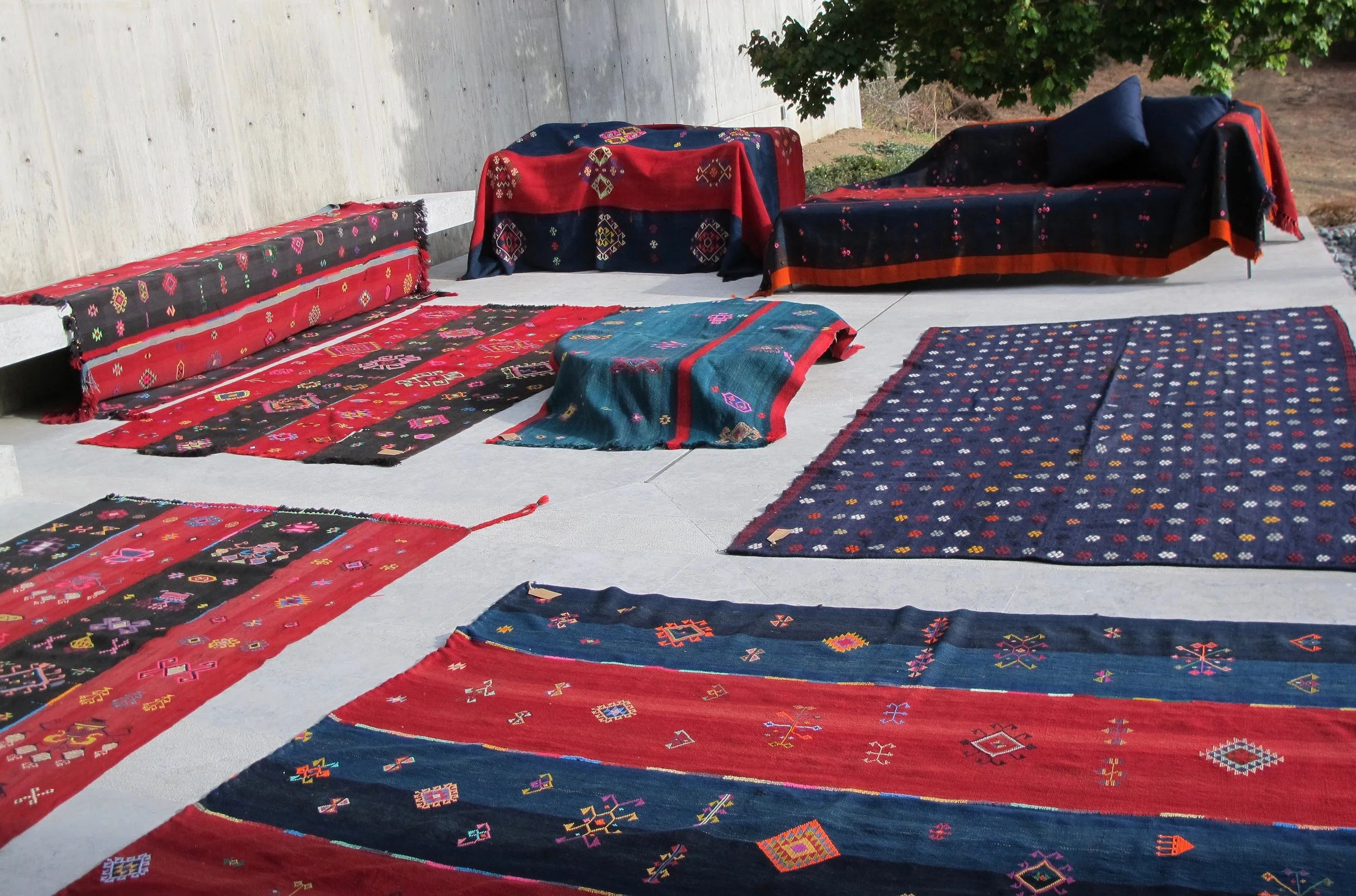Mezers
I bought my first mezer while living in southeast Turkey.
It covered a pair of stacked twin bed mattresses in my flat, making for an inviting, comfortable daybed. I brought it back to California with me and used it as a liner under the rugs I offered for sale until someone offered to buy it.
Mezers offer many interior design options
In my travels I came across other textiles called mezers and noted that their construction and appearance varied according to the region where they were made. I found that “mezer” in Kurdish translates roughly as “blanket” or “covering,” so the name mezer actually refers more to a textile’s purpose than to its technique or style, though most share similarities.
I’ve collected two very different types of mezers. The more widely known originates in the high Anatolian plateau of Turkey considered by many as Kurdistan. They are sometimes referred to as “perdahs” which makes sense, as “perdah” means curtain in Turkish and is another use to which mezers are commonly put. In this discussion, I’ll call them Anatolian mezers.
Mezers of the high Anatolian plateau
The Anatolian mezers in my collection traditionally served many uses, such as covers for household goods, easily rolled up and transported walls and entrance doors for tents, floor coverings, and quite often as room dividers, separating living and sleeping areas, women’s quarters from men’s, public spaces from private, and even as a nuptial curtain between a seated bride and groom!
They measure anywhere from five to eight or more feet in length, made up of from four to five panels in deep colors of red alternating with indigo or black, sewn together vertically side by side. The individual panels, from twelve to sixteen inches wide, are of tightly woven wool plain weave made on narrow looms that nomadic weavers could easily transport on pack animals. The panels are joined to one another with a flat cretan stitch. Occasionally, panels of dusky yellow and/or green may accompany the red and blue or black panels.
Mezer panels sewn together with cretan stitch
These Anatolian mezers are often adorned with brightly colored, or even metallic thread, in motifs of cicim (Turkish pronunciation is “djeejim,” not to be confused with jajim, a type of Persian textile) technique. Cicim can easily be mistaken for embroidery applied to the finished surface, but the design is actually threaded in as the textile is woven. Since the cicim yarns are often thicker than the primary structural yarns, the motif produced appears to sit on the surface.
Cicim motifs woven into mezer panels
A very different and less common sort of mezers come from a more narrowly defined geographic area, that of small villages in the Hakkari province of southeast Turkey, bordering Iraq and Iran. I’ll refer to them as Hakkari mezers.
A warp-faced mezer makes a beautiful and study couch cover
Hakkari mezers are generally of rectangular shape and, like Anatolian mezers are constructed of narrow panels about 15 to 20 inches wide, sewn together alongside each other. Likewise, they were created mainly for use as covers for floors and household goods, room dividers, bed covers, and draperies, in addition to being sometimes specifically made as prayer rugs.
A mezer made for use as a prayer rug (seccade)
I came across and purchased two of these mezers in my travels and couldn’t identify them until I came upon an online ASOL Journal article which, via a google translation, has been my source of information on these particular mezers.
Although other woven textiles such as kilims, carpets, baby carriers and saddlebags were produced for household use in Hakkari villages, the mezers are of different construction and more highly esteemed. They were woven on a narrow floor loom called a tevni which was made from the limbs of local trees such as mulberry and walnut.
Mezers produced on these narrow looms are warp-faced, in which the warp yarns (those going up and down) are so closely packed that the wefts (horizontal yarns) are hidden and result in a particularly strong and sturdy construction. The visible warp yarns yield vertically-oriented patterns of belts and stripes interspersed with bands of specific repetitive motifs expressing abstractions inspired by nature and unvoiced, heartfelt tribal sensibilities. Deep colors predominate: red and blue with muted inclusion of yellow, orange, green, purple, brown and pink accompanied by the natural wool colors of cream and black.
Mezer detail showing front and back with civciv gözü (chick’s eye) motif in three color schemes.
Mezer detail showing çengal (hook) motif in pink
Unfortunately, though the production of commercially viable kilims continues in Hakkari province, the creation of mezers ended in the 1990’s with the move from villages to urban centers when weaving lost its importance in meeting household needs. For the most part, the weaving of textiles for household use has become a lost art. However, many mezers have survived as highly prized items, carefully stored and preserved as family heirlooms which has made it possible for researchers to study them.
